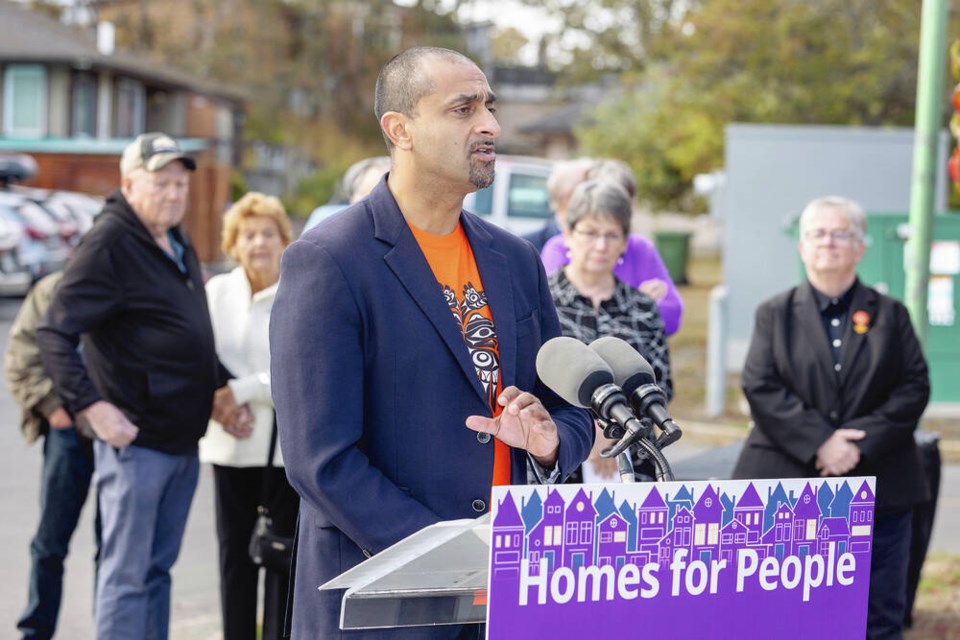I was at the Housing Central Conference in Vancouver this week. It’s a conference I’ve been attending for the past 10 years.
It’s a place to connect with people in the housing sector and share challenges and successes, and an opportunity to see the collective working in affordable housing across sa国际传媒 and the rest of Western sa国际传媒.
At the opening plenary on Monday morning, as Housing Minister Ravi Kahlon took the podium, a small demonstration began with a handful of people chanting: “You can’t house people if they’re dead” and unwrapping a canvas sign painted with the same words.
The demonstrators took turns speaking into a megaphone criticizing the non-profit sector, housing providers and Kahlon.
I was sitting in the front of the room, the megaphone only a few feet from my ear. Jill Atkey, CEO of sa国际传媒 Non-Profit Housing Association looked at Kahlon, and he gestured that the group should continue with its demonstration.
The group spoke, shared their views and encouraged the 1,800 people in attendance to walk out with them. They began by requesting a moment of silence for “all the people lost to unlivable non-profit housing.”
The moment of silence was respectfully observed by the delegates.
From the four years I have served on the Victoria-Esquimalt Police Board, I have learned about the right to protest, something that is taken seriously by VicPD. I, in turn, have learned to better understand this right for myself and others.
In Victoria, there are many protests and demonstrations at the legislature and other public areas throughout the year.
I am not sure if the same rights are at play at a private conference, but the demonstrators were provided some time for their voices to be heard.
Eventually, they were asked to leave.
As with most things in life, particularly controversial things, there is no right or wrong answer. With multifaceted issues, there is no definitive or “correct way” of viewing, solving or addressing issues.
When people are losing their friends, family and loved ones on the streets, outrage, anger, sadness and despair are understandable.
Many people working in the non-profit housing sector have also lost friends and family members to the streets, drug poisoning and other systemic issues stemming from the housing crisis. Many of them have experienced homelessness themselves.
“Preaching to the choir” is a fitting phrase for this situation.
Criticizing the entire non-profit housing sector at an affordable-housing conference with 1,800 people in attendance wouldn’t be the way I would choose to draw attention to my cause.
Kahlon was professional and respectful. I have always found it intriguing to watch leaders in tough situations — from a young age, I have studied how people respond.
Kahlon’s integrity and compassion were demonstrated through his demeanour in this moment.
I hope that if I find myself in a similar situation one day, I would respond as he did.
The Housing Central Conference is a staple in the affordable-housing sector, and each year I see the drive, innovation and tenacity of leaders in the sector who continue to persevere during this housing crisis.
I am not diminishing the drive the demonstrators had for their cause. There were probably hundreds of people in that room who shared their frustration, sadness and anger about the housing crisis and the additional challenges of housing people with complex needs.
Each of us has the right to protest.
As a communications professional, I know that the first step in sharing a message is to determine the audience, and then tailor the key message to the audience.
When the assumption is made that current non-profit housing providers are the problem, or the housing minister is the problem, it creates a situation where people who could be a close ally are viewed as villains.
To solve the housing crisis, we need to work together. If we point fingers at each other, it slows down the process of moving forward, and prioritizing the people who need it the most.
Charla Huber is an Indigenous communications consultant based in the capital region. Her family is from Beausoleil First Nation and Fort Chipewyan.



